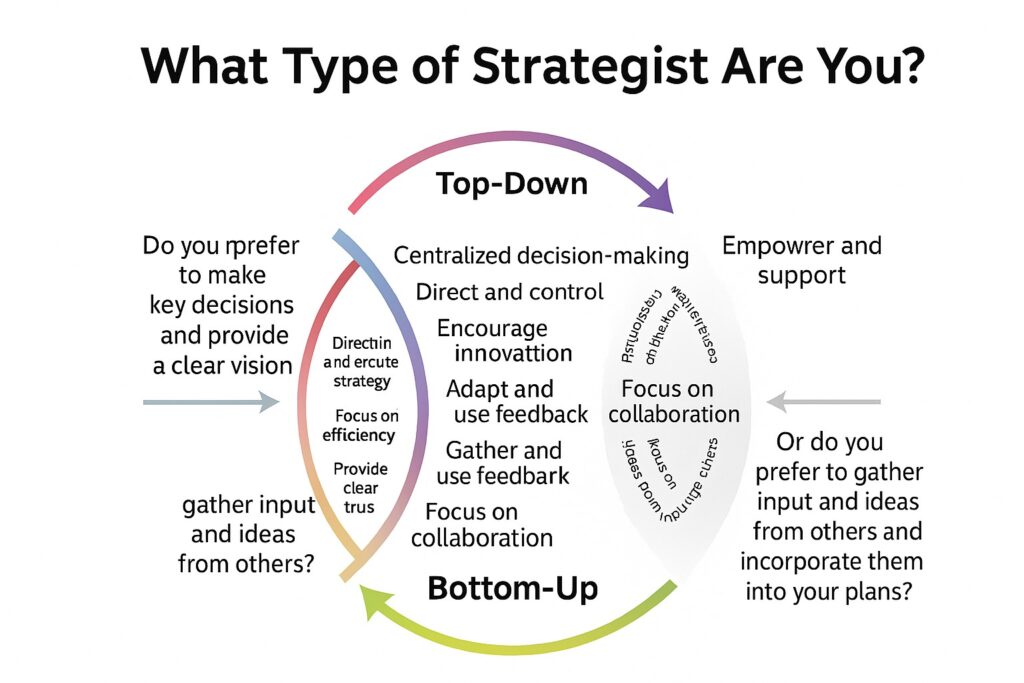தலைமைத்துவத்தில் 6 முக்கிய பாணிகள்
ஒரு தலைவன் வெற்றியடைவதற்கு முக்கிய காரணம் அவரது உத்திசார்ந்த சிந்தனை (Strategic Thinking). ஒவ்வொரு தலைவரும் சவால்களை வெல்லவும், இலக்குகளை அடையவும், தங்கள் சொந்த பாணியில் உத்திகளைப் பயன்படுத்துவார்கள்.
அதில் 6 வகையான உத்தி வல்லுநர்கள் அடையாளம் காணப்பட்டுள்ளனர்.
1. அரசர் (The Regent – Top-Down Strategist)
• விளக்கம்: அதிகார மையப்படுத்தப்பட்ட தலைமை. முடிவுகளை மேலிருந்து எடுப்பவர்.
• உதாரணம்: அரசியல் தலைவர்கள், படைத்தளபதிகள்.
• Case Study: இராணுவத் தளபதி ஒருவர், போர்க்களத்தில் தானே உத்தரவு வழங்கி படையினரை இயக்குவது.
இன்றைய பயன்பாடு: அவசர நிலைமைகளில் விரைவான முடிவுகள் எடுக்க வேண்டியபோது இம்முறையைப் பயன்படுத்தலாம்.
2. சேவகர் (The Servant – Bottom-Up Strategist)
• விளக்கம்: குழுவினரின் எண்ணங்களை முன்னிலைப்படுத்தி, அவர்களை வளர்ப்பவர்.
• உதாரணம்: NGO தலைவர்கள், சமூகத் தலைவர்கள்.
• Case Study: மக்களின் தேவைகளை கேட்டறிந்து, அதற்கேற்ப திட்டங்களை உருவாக்கும் சமூக அமைப்புத் தலைவர்.
இன்றைய பயன்பாடு: சமூக வளர்ச்சி மற்றும் மக்கள் பங்கேற்பு தேவைப்படும் சூழலில் சிறந்தது.
3. புதுமை படைப்பாளர் (Creative Strategist)
• விளக்கம்: புதுமை, படைப்பாற்றல், வேறுபட்ட அணுகுமுறை கொண்டவர்.
• உதாரணம்: விளம்பரத் துறையின் creative directors.
• Case Study: ஒரு நிறுவனம் புதிய விளம்பர யோசனை மூலம் சந்தையை கவர்ந்தது.
இன்றைய பயன்பாடு: போட்டியாளர்களை வெல்ல புதுமை தேவைப்படும் சூழலில் உகந்தது.

4.மூத்தவர் (The Elder – Conservative Strategist)
• விளக்கம்: அனுபவம், பாரம்பரியம், நிரூபிக்கப்பட்ட நடைமுறைகளை நம்புபவர்.
• உதாரணம்: ஆலோசகர்கள், மூத்த கல்வியாளர்கள்.
• Case Study: பல ஆண்டுகளாகப் பரிசோதிக்கப்பட்ட முறைகளைப் பயன்படுத்தி நிறுவனம் நிலைத்தன்மையைப் பெற்றது.
இன்றைய பயன்பாடு: அபாயம் அதிகமுள்ள சூழலில் பாதுகாப்பான தேர்வுகள் எடுக்க.
5.அந்நியர் (The Stranger – Adaptive Innovator)
• விளக்கம்: வெளிப்புற பார்வையுடன் புதிய சிந்தனைகளை கொண்டு வருபவர்.
• உதாரணம்: வெளிநாட்டு ஆலோசகர்கள், start-up founders.
• Case Study: இந்தியாவிலிருந்து வந்த ஆலோசகர், இலங்கை சந்தைக்கு புதிய வணிக முறை கொண்டு வந்து வெற்றி பெற்றார்.
இன்றைய பயன்பாடு: உலகமயமாக்கல் சூழலில், வெளிநாட்டு அனுபவங்களை உள்வாங்கும்போது.
6. முள்ளம்பன்றி உத்தி (The Hedgehog – Focused Strategist)
• விளக்கம்: ஒரே இலக்கில் கவனம் செலுத்தி, உறுதியுடன் முன்னேறும் தலைவர்.
• உதாரணம்: ஒரு நிறுவன founder, ஒரே தயாரிப்பை மேம்படுத்துவதில் கவனம் செலுத்துவது.
• Case Study: Google முதலில் search engine ஒன்றிலேயே கவனம் செலுத்தி, பின்னர் உலகின் முன்னணி நிறுவனமாக வளர்ந்தது.
இன்றைய பயன்பாடு: ஆரம்ப நிலையில் உள்ள நிறுவனங்கள், ஒரு தயாரிப்பு அல்லது சேவையில் மட்டும் கவனம் செலுத்தும் போது.
ஒவ்வொரு தலைவரும் தங்கள் சூழ்நிலை, நிறுவனம், குழு ஆகியவற்றின் தேவைக்கேற்ப இந்த ஆறு உத்தி பாணிகளில் ஒன்றையோ, பலவற்றையோ பயன்படுத்துவார்கள்.
ஒரு சிறந்த தலைவர் சூழ்நிலைக்கு ஏற்ப அரசராய், சேவராய், புதுமை படைப்பாளர், மூத்தவராய், அந்நியராய், அல்லது முள்ளம்பன்றி உத்தியாய் மாறத் தெரிந்திருக்க வேண்டும்.
தொடர் கட்டுரையில் கடந்த கட்டுரையினை படிக்காவிட்டால் அதனை படிக்க..
https://maatramnews.com/articles/three-types-of-leadership/
மேலதிக தகவல்களுக்கு மாற்றம் செய்திகள் இணையத்தளத்தினுள் பிரவேசியுங்கள்.
மேலதிக தகவல்களை உடனுக்குடன் பெற்றுக்கொள்ள மாற்றம் செய்திகள் முகநூல் பக்கத்தை பின்தொடரவும்.

6 Major Styles in Leadership
A leader’s success largely depends on strategic thinking. Every leader has their own way of applying strategies to overcome challenges and achieve goals.
Six types of strategic leaders have been identified:
- The Regent – Top-Down Strategist
Description: Leadership based on centralized authority. Decisions are made from the top.
Examples: Political leaders, military commanders.
Case Study: A general who directs soldiers on the battlefield by issuing direct orders.
Modern Application: Best suited for emergency situations where quick decisions are required.
- The Servant – Bottom-Up Strategist
Description: Prioritizes the team’s ideas and helps them grow.
Examples: NGO leaders, community leaders.
Case Study: A social leader who listens to people’s needs and creates programs accordingly.
Modern Application: Ideal for community development and situations that require public participation.
- The Creative Strategist
Description: Emphasizes innovation, creativity, and unique approaches.
Examples: Creative directors in advertising.
Case Study: A company attracts customers with a new and original marketing campaign.
Modern Application: Effective when innovation is necessary to beat competitors.
- The Elder – Conservative Strategist
Description: Relies on experience, tradition, and proven practices.
Examples: Consultants, senior educators.
Case Study: A company achieves stability by using time-tested methods.
Modern Application: Best for high-risk situations where safe choices are needed.
- The Stranger – Adaptive Innovator
Description: Brings fresh perspectives and new ideas from outside.
Examples: Foreign consultants, start-up founders.
Case Study: An Indian consultant introduces a new business model in Sri Lanka and succeeds.
Modern Application: Useful in globalization contexts where external experiences must be adapted locally.
- The Hedgehog – Focused Strategist
Description: A leader who focuses on a single goal with determination.
Examples: A founder concentrating on perfecting one product.
Case Study: Google initially focused only on its search engine before expanding into a global leader.
Modern Application: Best for early-stage companies focusing on one product or service.
Conclusion
Each leader applies one or more of these six strategic styles depending on their circumstances, organization, and team needs.
A great leader knows how to adapt—becoming a Regent, Servant, Creative Strategist, Elder, Stranger, or Hedgehog—based on what the situation demands.




Pingback: கூட்டங்களை பயனுள்ளதாக்கும் ஆறு கேள்விகள்